Kerala: Forest Garden, Home Garden, Fantasy Garden

Just before I left on my holiday to India, a former colleague from Oxford Botanic Garden pointed out that Kerala is an area of great horticultural interest for its “forest gardens”. These are sustainable gardens around a residential house, from which the owners either consume or sell on produce. They are therefore commonly known in this area simply as “home gardens”. They are informal in arrangement, and are known in horticulture as forest gardens because they are an example of “agro-forestry” – where trees provide a protective canopy and cropping plants are added in a series of layers beneath. A small ecosystem is formed over the years of cultivation, where there is usually a good balance of moisture retention, and nutrients being returned to the soil.
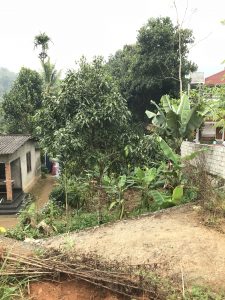
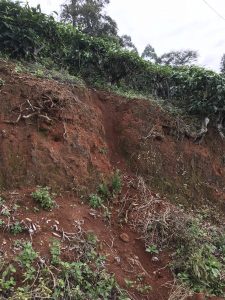
In many situations, trees are problematic – making the ground difficult to work and sucking in moisture – but in this environment they are an aid. They help control the level of moisture, shielding from heavy rain and from baking sun. Their leaves will provide organic matter as they fall (in a tropical climate, leaves fall gradually as they age rather than a mass autumn leaf drop), returning nutrients to the soil. Their roots help to anchor the light soil when flash flooding washes the surface covering away in other areas. They also interact with the other plants. In a tropical climate many plants are specifically adapted in nature to grow at the different levels of the forest: climbers make use of the trees for support; ground cover plants employ different methods of photosynthesis to compensate for lower light levels.
Anything to do with crops and home produce would usually make me think of allotments – rows of veg and the occasional flower. I’ll admit I find it a rather dull part of horticulture. There. I said it. I’m not an enthusiastic vegetable gardener.
However when the crops are transformed to the kind of exotics they have here in Kerala, suddenly I’m excited. The thought that the glasshouse plants I go a bit dreamy over in the UK are all just sitting here in everyone’s back yard makes me want to rush out and get cropping.
I attempt a quick bit of research before my trip. It’s quick, as I only have a few hours to do it. But I find that, apart from a few journal items tucked away in Indian eco websites, and a very brief Wikipedia mention, relatively little seems to have been written and made freely available about the “home gardens” of Kerala. So I leave with only a vague idea of what I’m looking for and a promise to report back to my friend “if” I find anything.
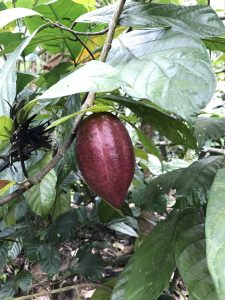
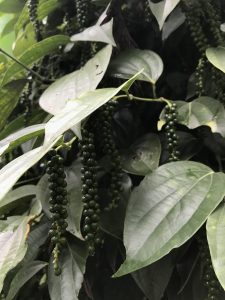
On my third day in Kerala, we drive up from Kochi towards Munnar in the Western Ghats. En route I keep thinking I might be spotting a “home garden”, as I catch a glimpse of the odd banana (Musa sp.) or coconut palm (Cocos nucifera) next to a house. We stop at a spice garden, where the guide shows us the local staples – cardamom (Elettaria cardamomum), coffee (Coffea sp), cloves (Syzygium aromaticum), pepper (Piper nigrum), chocolate (Theobroma cacao), ginger (Zingiber sp.) , lemongrass (Cymbopogon citrates) and nutmeg (Myristica fragrans).
We arrive quite late at our hotel, which is in a quiet river valley outside Munnar, 1500 metres up in the mountains. Munnar is known for its tea plantations, and there also seems to be plenty of land covered in other lush vegetation, but I go to sleep slightly perturbed about how to find these elusive productive gardens. I have left a few messages on online forums asking people who say they have found and photographed gardens before for help, but no one has responded.
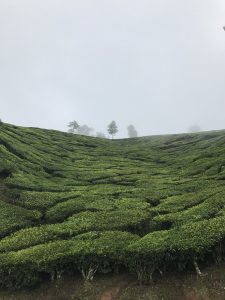
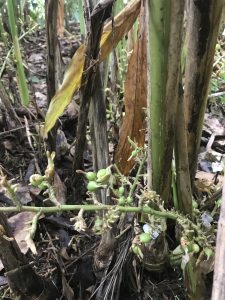
After breakfast next morning, the guide for my trek through the tea plantations fails to materialise. So I wander across the road from the hotel. And spot that the garden round the small house opposite has some pepper and some coffee growing in it. And then the next house’s garden has coffee and pepper and cardamom. I realise I’m surrounded by these home gardens. Every home has coffee beans ripening on plants in the front area, and some are drying their beans on mats by the road. Cardamom is everywhere, in thick clumps through gardens and dotted in the surrounding forest. Cassava (Manihot esculenta) is also rife. Cocoa pods hang
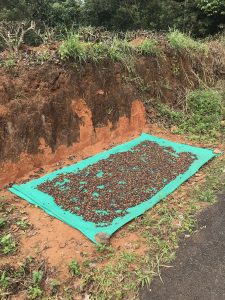
tantalisingly at regular intervals along the road, and the leafy Theobroma trees are amongst the most common in gardens, creating shady groves. And bananas, so many bananas. Pepper – an avid climber – romps over almost every upright structure. Papayas (Carica papaya) tower above. These are not really gardens in the same sense that we would recognise. They are plots around houses which on first impression seem to be part of the surrounding forest. It’s only on closer inspection that you realise the majority of trees closer to houses are the ones which crop, and that the clumps of vegetation under them are invariably also useful and edible plants, with small areas of soil worked around them. Many gardens also seem to have plastic or concrete water tanks in them, I assume for ease of watering when needed. The gardens also have other functions – clothes are being dried, birds are kept in cages.

I talk to a few home owners – but a language barrier prevents me from getting fuller knowledge from them. I can see that a lot of care and effort goes into the gardens – planting, clearing the ground around crops, watering and harvesting. Cardamom appears to be a key crop, and I assume from the quantities all around that it is sold to generate additional income for the household, but don’t have the opportunity to ask people about the economics of their plots. The trip out with the guide the next day reveals more gardens – some larger and more like smallholdings. He explains that these are like individual farms and that the crops are for profit. Indeed in some small plots between houses I see cassava or banana planted more intensively, in neat rows. And then in one smallholding we find the most complete mix I have seen: An entrance way through trees adorned with pepper leads into a shady grove of bananas and cocoa, where taro (Colocasia esculenta), ginger, turmeric (Curcuma longa) and cardamom grow underneath, along with a few small cassava. A large water tank sits fairly centrally, with betel leaf (Piper betle) climbing up the side.
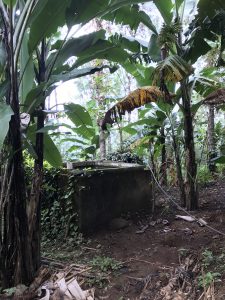
It’s idyllic, but also clearly the result of hard toil. Everything is worked by hand – these plots definitely aren’t accessed by machinery and there is no sign of power tools. It’s my fantasy mix of lush, eye-popping and exciting plants. It’s also inspiring. In the UK, we sometimes grow these plants for ornamental purposes, or in an educational setting to display crops of economic importance, but seeing them grown at subsistence level like this has added a whole new level of meaning.